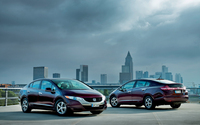Honda Presents Fuel Cell Electric FCX Clarity - VIDEO FEATURE
HONDA – DRIVING FOR THE NEXT HUNDRED YEARS
 |
LONDON - April 29, 2010: Over one hundred years have passed since the birth of the automobile. As we look for better ways to create and harness energy for transportation, Honda remains focused on creating sustainable mobility.
We are looking toward the next hundred years and exploring the challenge of new fuels and powerplants. We’re working to keep the dream of personal mobility alive for generations yet to come.
Fuel cell electric vehicles (FCEV), which run on hydrogen and emit no CO2 or other harmful emissions, may be the key to securing a bright future for the automobile in society. Honda became the world’s first carmaker to put a fuel cell car on the road, delivering the Honda FCX to fleet users in the US and Japan in 2002.
Now we are ready to make another great leap forward, introducing a fuel cell electric vehicle that delivers superior environmental performance and is fun to drive: the FCX Clarity.
Click PLAY to watch video
HOW HONDA’S FUEL CELL ELECTRIC VEHICLE WORKS.
A fuel cell vehicle has a hydrogen tank instead of a petrol tank. In the
fuel cell stack, hydrogen is combined with atmospheric oxygen to generate
electricity. No CO2 or other pollutants are emitted in this process. The
only emission is water.
 |
A compact and efficient lithium ion battery stores electricity generated during braking and deceleration in regenerative braking. When more power is needed, the battery works in harmony with the fuel cell stack as a supplementary power source.
Because the vehicle is propelled by an electric motor, it delivers smooth, powerful acceleration and quiet operation, without the noise and vibration associated with an internal combustion engine.
It is the ultimate in clean performance.
AIMING FOR A SUSTAINABLE-ENERGY SOCIETY FREE FROM DEPENDENCE ON FOSSIL
FUELS.
In an ideal hydrogen cycle, hydrogen produced from water via
electrolysis using solar, wind, hydroelectric and other renewable energy
sources would be used in fuel cells to generate electricity for use in cars
and to meet other energy needs. The water produced as a by-product of this
process would then return to the rivers and oceans before once again being
converted into hydrogen via electrolysis. By realising such a renewable,
water-to-water energy cycle, it may be possible one day to create truly
sustainable energy supplies, freeing society from dependence on
non-renewable and carbon-based energy sources.
Click PLAY to watch the original introduction of the FCX Clarity at the 2007 LA Auto Show



